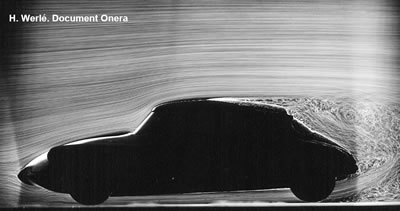- ONERA
- Research - Aeronautics Space Defense
- Scientific Publications
Lessons, presentatons, conferences
Separation in Three-Dimensional Flow: Critical Points, Separation Lines and Vortices
Jean Délery
Emeritus Advisor at Onera
Jean.Delery <@> free.fr
Sommaire
>> Part 1 - Introduction. The Critical Point Theory and Three-Dimensionnal Separation

>> Part 2 - Detachment and Attachment Separation Lines. Detachment and Attachment Separation Surfaces

>>Part 3 - Topology of Some Remarkable Three-Dimensionnal Flows

>> including - Afterbody Flows

>> Part 4 - Two-Dimensional Separation Revisited with the Three-Dimensional Concepts or a Case Apparently Simple!

NAOS - Nasmyth Adaptive Optics System

The Very Large Telescope
was built by the European Southern Observatory (ESO).
The Very Large Telescope (VLT)
The European Southern Observatory's Very Large Telescope is made up of four telescopes, set up on the top of the Paranal mountain in northern Chile. Attached to the focus of one of the telescopes, NAOS contributes to correct for the blurring effects of Earth's atmosphere.
If you consider a perfect telescope used in a vacuum, resolution is directly proportional to the inverse of the telescope diameter. Indeed, areas of cold and warm air mixing in the atmosphere generate turbulence, which affects the resulting image quality. As a consequence, whatever the size of your telescope, you will not be able to increase its resolution - i.e. its ability to produce a more detailed picture - if you can not overcome the turbulence limitation.
One solution is to build telescopes on mountains, where the air is calmer and more transparent. The Paranal mountain was chosen because of its excellent atmospheric conditions and its remoteness. Yet, without corrective optics, the VLT would reach the theoritical resolution of a 45-centimeter telescope in spite of its 8-meter mirror.
Another way has been considered since 1946: space-based telescopes. This eventually became technically possible and the Hubble Space Telescope (HST) was launched in 1990. The HST has a 2.4-meter mirror diameter, but is outside Earth's atmosphere, hence its better resolution.
Today, adaptive optics systems correct for image degradation to produce the sharpest images ever obtained. In practice, this is done with computer-controlled, flexible mirrors which re-focus the blurred images up to 100 times per second to compensate for atmospheric turbulence. Thanks to NAOS (Nasmyth Adaptive Optics System), set up at the end of 2001, the resolution of the VLT is three times the resolution of the HST.
The ground-based telescopes now achieve the theoritically possible resolution in the infrared. They might reach this limit in the visible when the seeing conditions are particularly good.
Adaptive Optics Principle

Des détails jusque là inobservables révélés
L'optique adaptative apporte au télescope le moyen de sonder l'univers beaucoup plus loin, tout en menant des analyses beaucoup plus fines des objets observés. Pendant les 10 années de la vie prévue de NAOS, le VLT fournira aux astronomes européens l'outil indispensable à l'étude des planètes du système solaire, des environnements stellaires (enveloppes et disques protoplanétaires), ou de l'évolution des galaxies, pour ne citer que quelques exemples.
Consortium
NAOS has been designed and manufactured by a French Consortium, composed of the French National Aerospace Research Establishment (ONERA), Paris Observatory (ODP) and Astrophysics Laboratory of the Grenoble Observatory (LAOG) in collaboration with ESO.
Links
- NAOS at ESO (European Southern Observatory)
http://www.eso.org/projects/aot/
- Laboratoire d'AstrOphysique de Grenoble
http://www-laog.obs.ujf-grenoble.fr/ - Laboratoire d'Etudes Spatiales et d'Instrumentation en Astrophysique
http://www.lesia.obspm.fr/
